In 2019, our industry sector report revealed DFS to be the top brand in terms of online visibility and SEO. They have an overall visibility of 29,420. This makes them the official market leader.
With this in mind, we became curious as to what they were doing to absorb this much visibility. What strategies were they utilising that the smaller brands weren’t and how can other brands copy them to reap the same rewards?
The methods and strategies we uncovered don’t rely on large budgets and don’t require ‘insider knowledge’ or years of experience. They are tweaks and changes any brand can make to dramatically improve their ROI on their SEO campaigns.
Jump to:
- The perfect category structure
- Doorway pages that get results
- Exclusive partnerships and collaborations
- Buying guides and advice for eager furniture customers
- A killer backlink profile
Let’s dive straight in with looking at DFS’s category structure.
The Perfect Category Structure
Any good, well-kept eCommerce store will know the key to pleasing Google is to have a crystal-clear category hierarchy. If you’re not giving both your users and Google Bot a clear path to follow, it’ll make it difficult to find specific, important pages.
DFS knows exactly what they’re doing with their category structure – something many brands on the report seem to struggle with. They have cleared out the junk and have designed a super simple navigation that is not only helpful for users but also bots. This results in a reduced crawl budget, better indexability, and greater visibility (as this all signals a healthy, authoritative site).
Let’s investigate what they do specifically so you can copy it.
The ‘Silo Structure’ Which Googles Loves to Crawl
Siloing is an age-old SEO term that’s dated back for years. It was heavily used in the Blackhat world of SEO when optimising affiliate sites and spamming them with trashy backlinks. Now, it’s used in eCommerce and as a way to describe how categories should follow a semantic, relevant structure.
This is a brief example of what category Siloing looks like:
[ ‘Leather Sofas’ > ‘Corner Leather Sofas’ > Filter Parameters ]
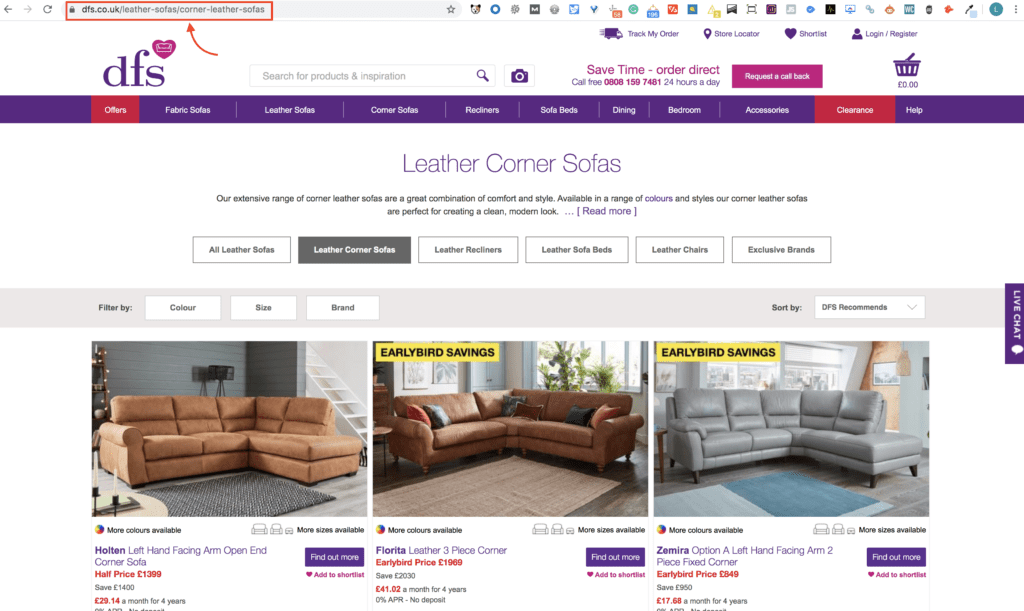
Categories follow a semantic structure where all the sub-category relate to the main category. This deepens the topical relevancy of the category and lets Google know exactly what the category is about, helping with rankings.
As well as a simple category structure, the URL pathways also clear up any confusion. DFS uses simple URL structures which search engines love.
Here’s an example:
/leather-sofas/corner-leather-sofas
These URLs don’t have any difficult confusing URL coding in them. Both users and Google know exactly what this category is about and how each category naturally follows the other.
You’d be surprised how many sites in the analysis had numbers and strange parameters that were hurting their SEO.
To see if your brand was affected by this, download the report here.
Keywords Optimised to the Fullest
Not only are the categories structured correctly in the sitemap and in the URL – but they’re also optimised for the high priority keywords in this industry.
If you take a look at the search volume for the names of all the main categories, they all, interestingly, are the search terms with the highest search volume. The only exception here is with the keyword ‘recliner chairs’ but this is excluded from the main navigation because it would limit the scope of the category.

DFS know exactly which keywords they should be targeting and have created main categories around them. The less important keywords with less search volume are introduced as sub-categories. Some of these are still high volume in the grand scheme of things, but they don’t come close to that of the main term.
Many brands are tempted to get as many longtail or keyword variations into their main navigation as possible. We’ve seen it in both the lighting and jewellery industries, and it can have a negative impact.
The best practice is to have the large, heavy-hitting terms in the nav and as sub-categories and place the less important terms as either filter pages or include them into the copy of the main page to give the category a semantic boost.
Is your brand guilty of targeting less important terms in the navigation? Are you an offender of stuffing the navigation with tons of categories? Get a free audit and find out how serious the problem is.
Doorway Pages That Get Results
DFS is making use of incredibly effective doorway pages for monster keywords in the sofa industry.
A ‘doorway’ page is still a fairly uncommon thing to see in the world of SEO. Many old school SEOs are still relying on plain, boring product listing pages. They’re not completely satisfying the intent of the searcher.
We’ve seen dwell times skyrocket to 5 minutes and bounce rates decrease to as low as 10% with some doorway pages for our client. It’s to no surprise that DFS are dipping their toes into this strategy and reaping the rewards in the form of visibility.
A doorway page is essentially a step in front of the product listing page that allows users to select exactly what they’re looking for. When someone searches ‘sofa beds’, they’re not sure on which sofa bed they want. As a result, they may become lost if they’re given a list of random products.
Doorway pages filter that intent and let searchers find the kind of product they have in mind. The customer journey is reduced and make simple. From this, bounce rates diminish, and conversions supercharge.
The ‘Sofa Bed’ Page – A Behemoth of Traffic Potential
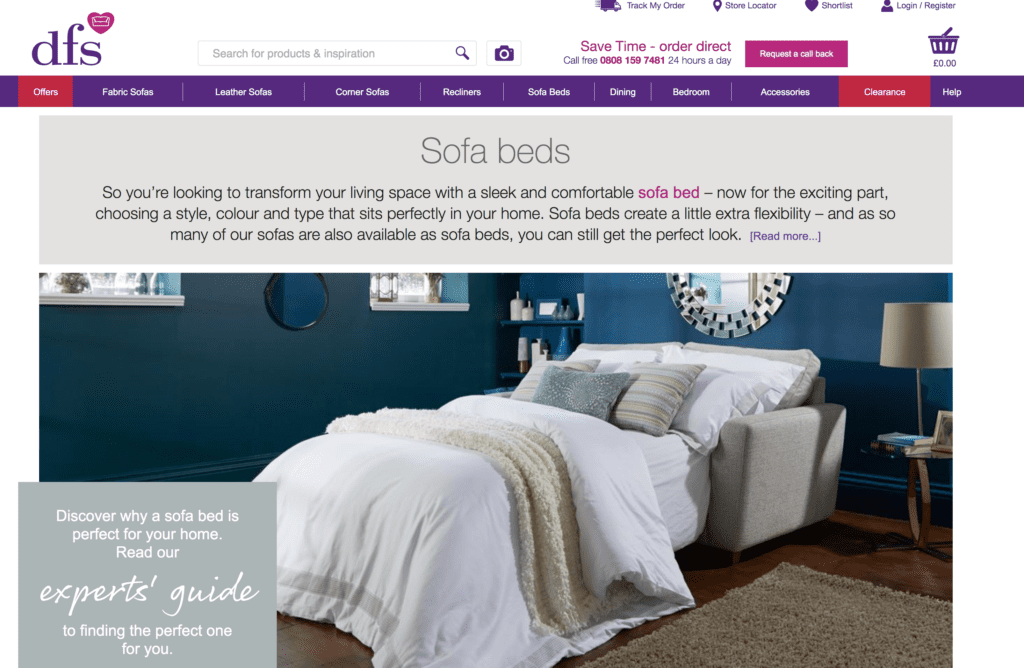
One of the best-performing pages on DFS is their sofa bed page. This is a doorway page and received a tsunami of traffic. It currently ranks third for the main terms, sucking in over 100K of impressions each month.
If you’re interested in how we engineer these pages and get them ranking for huge terms just like this, we suggest you get in touch immediately for a free chat and audit.
Exclusive Partnerships and Collaborations
In recent years, we’ve seen large, popular brands collaborate with each other to create some impressive products. Whether it be shoes, hoodies or t-shirts, collaborations can generate a lot of buzz and can lead to improved visibility. In some cases, as with DFS, it’s actually created some coined terms which are exclusive to them and their brands.
A Lesson from Supreme and Nike
We’ve seen Nike and their Jordan’s Range do some impressive collaborations with brands like Supreme which enable them to sell a ton of shoes at an incredibly high price point. The exclusivity and limited-time event boost the perceived value of their products.
Brands like DFS have learnt from these events and have done some collaborations of their own.
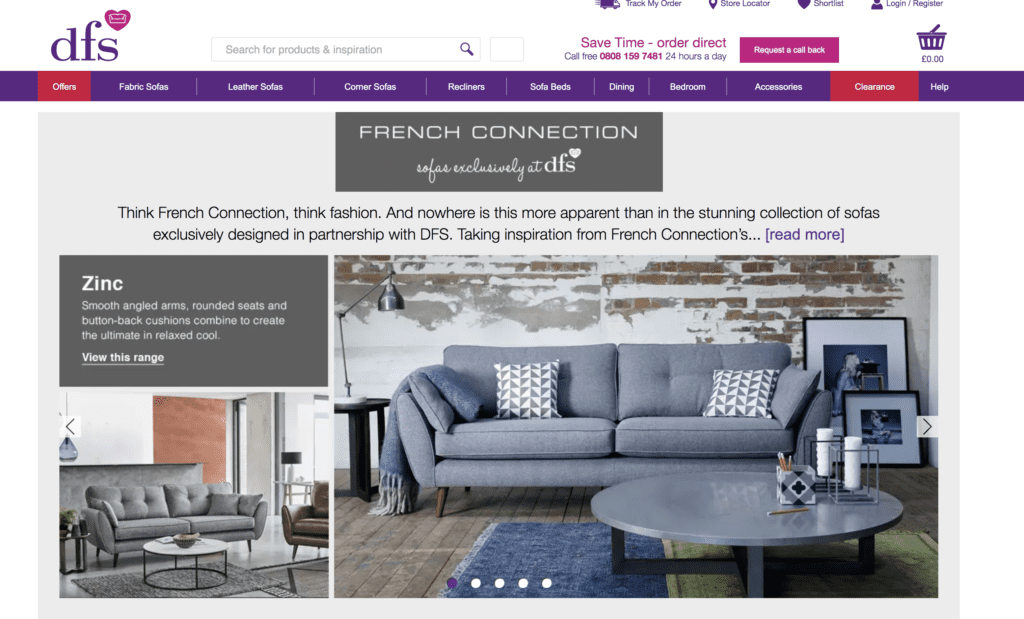
Their French Connection collaboration saw the creation of a French Connection sofa. The page got 21 backlinks from 15 referring domains and ranks for newly coined terms, such as ‘DFS French Connection’ which receives 1.5K a month.
If your brand is looking to coin new terms, boost awareness, and improve visibility, look for brands to team up with and create an awesome product together.
Competitions with Reputable Associations
As well as new, unique products, DFS also do collaborative competitions with large brands and organisations. Their most recent one was with Team GB.
Competition collaborations could be a low entrance barrier for smaller brands who don’t have the means to create new products. They could team up with local organisations or national charities to drive awareness together.
For DFS, this created a tidal wave of press from papers such as The Times.
If you’re interested in devising a strategy just like this to boost your SEO and online marketing, get in touch with our team today.
Buying Guides and Advice for Eager Furniture Consumers
Buying guides have been a go-to strategy for us in recent years. They’re an excellent way to thicken and deepen a category to boost its semantic relevancy and give Google more of an idea of what that category is about.
DFS have been using this strategy as well. They have a wide range of buying guides which give their site a plethora of consideration content, helping consumers move closer to the final purchase decision.
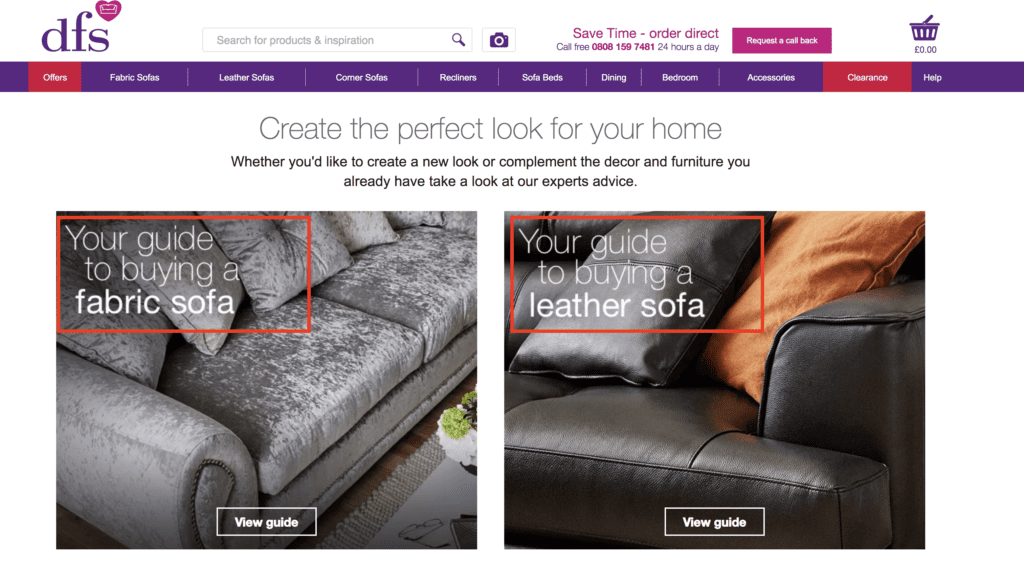
In our own research, we’ve found these kinds of buying guides and consideration content to have a significant effect on the position of the main category.
Content to get you Inspired
Their inspiration section is extensive and has 20 referring domains just on the category’s home page. This section is filled with colour schemes and useful advice on how to style a bedroom with your DFS furniture.
Not only does this help consumers make a better and more comfortable decision when purchasing a sofa; it also helps to establish DFS as an authority in their niche. Some of their advice articles get backlinks as well.
Take a look at DFS’ inspiration content and see where you can apply some of the tactics they’re using to improve their visibility and make more sales.
Plan Your Room with Ease
Tools are an excellent way to engage your audience and build up the backlink profile of your site, especially if the tool solves a prevailing problem experienced by your ideal customer.
DFS has a very interesting tool which helps you plan your room. This tool lets you place DFS products into a room with predefined dimensions. It’s very helpful if you’re struggling to visualise where all your new furniture will sit.
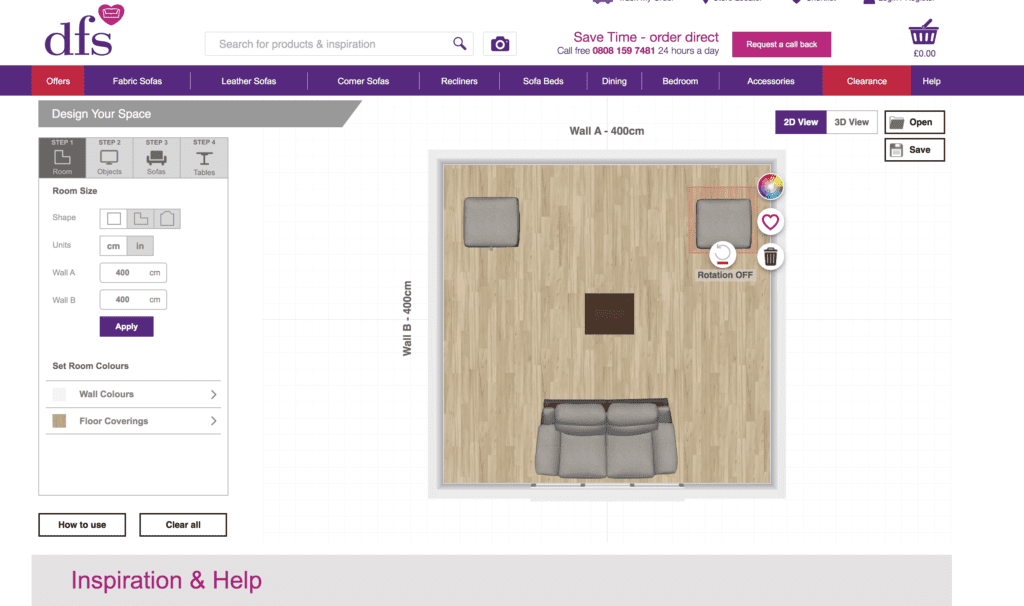
This tool currently ranks at position 6 for the keyword ‘room planner’ which has a monthly search volume of 7.6K. DFS are reaping the rewards from creating a simple, innovative tool such as their room planner.
You can learn something here. Have a think about what problems or concerns your audience is facing when it comes to purchasing sofas and other furniture. From this, you can design a simple tool to help them overcome this problem. It could be a checklist, a colour matcher room helper, or something else.
A Killer Backlink Profile (DFS’s Strategies Revealed)
A great backlink profile is needed no matter what industry you’re in. Backlinks have been a key part of SEO for years and every man and his dog are aware that, without backlinks, you’ll struggle to compete on the SERPs.
DFS has a comprehensive backlink profile consisting of thousands of links. Many of which come from incredibly high authority sites, such as the BBC, The Telegraph, and The Guardian.
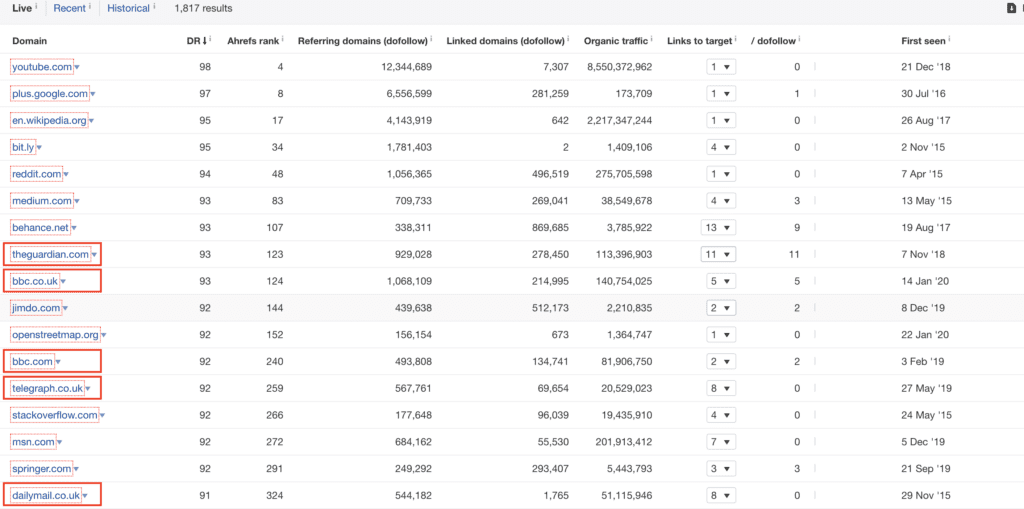
How has DFS created all these backlinks? What methods are they using to magnetise all these mentions?
Deals and Discounts Which Get Impressive Coverage
One of the most consistent backlinks which come from authority sites is in relation to the deals that have on at different times of the year.
When the seasonal sales and one-time events come into the public sphere, newspapers and associated sites jump on to the hype and often create articles rounding up the best deals of the occasion.
Think of how you can use this similar strategy. Your brand is bound to have deals on regularly, so how can you push them out to papers and sites to let them know what you have on offer?
It can be good practise to have a permanent sales page as well. You’ll develop links to it and the last thing you want to happen is for all the links to disappear into a black 404 hole.
Collections and Trends That Get Links Organically
In the furniture and sofa retail space, trends and styles are everything. A lot of the links DFS has picked up for certain products which have been included in collections and trend-based articles on authority websites.
Although many of these would have occurred naturally, if not by chance, you can use this idea as a way to get more links to your product pages.
Why not experiment with putting your products forward to reviewers and sites, or asking journalists to add them in their article via outreach? You could put forward products and get them featured in collections on sites like BBC and The Times, just like DFS.
We’re specialists in backlink generation and have been doing it for years. If you want to see how we could boost your site, get in touch today.
There’s Always More to Discover…
This quick audit is only scratching the surface of DFS’ SEO success. Bear in mind, we don’t have access to log files, sitemaps, analytics, and much more.
This is all based on what we can observe with the site, as well as our experience of working with a wide range of brands in a variety of industries. We work with big players, such as Dreams, Laura Ashley, and Co-op.
What do you think we could audit if we had unrestricted access to the site? What optimisations do you think we would have found?
If you’re curious as to how we can optimise and use our experience to take your site to new heights, get in touch immediately and get a free audit today.
